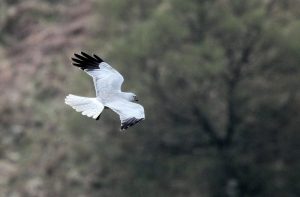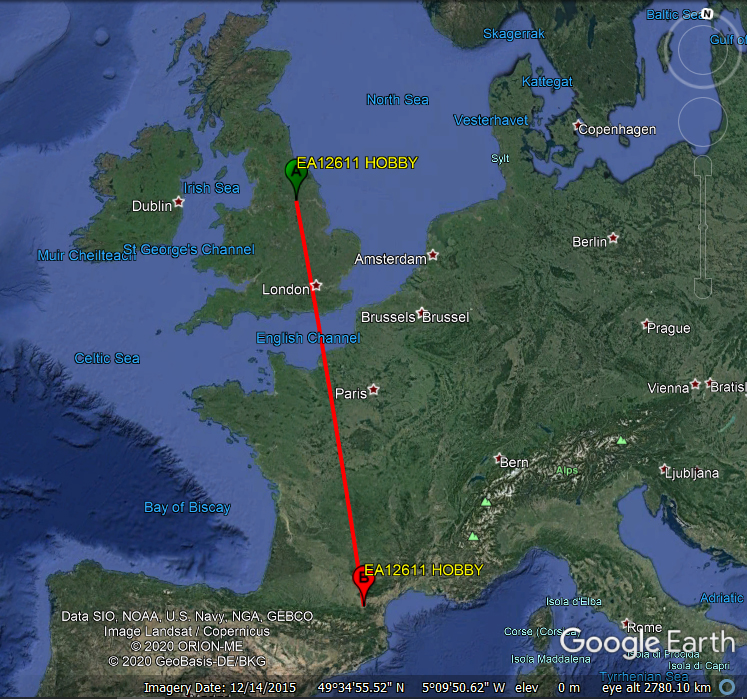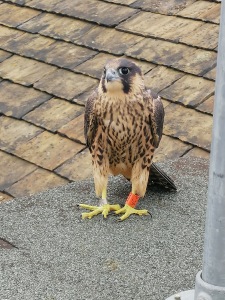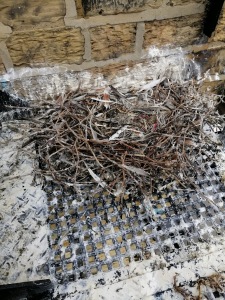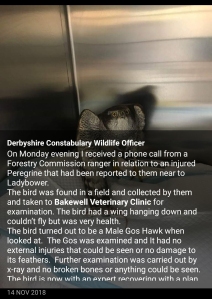Disappointingly we have to report that due to the sudden disappearance of two male Hen Harriers. Two active Hen Harrier nests in the Upper Derwent Valley area of the Peak District National Park, (each containing five eggs), have been abandoned.Whilst there is no direct evidence linking a crime we are closely liaising with the National Trust, the Police and the NWCU along with other partner agencies to ascertain the fate of the birds.
Northern England Raptor Forum Fund Raising for Hen Harrier Satellite Tags
Dan Evans and NERF are auctioning a beautiful piece of artwork to help NERF raise funds to support the RSPB Investigations team purchase Hen Harrier Satellite tags
You can read more about the fund raising HERE

You can bid on the artwork HERE
Alternatively you can buy a print HERE
Finally you can donate directly at https://www.justgiving.com/fundraising/hen-harrier-sat-tags
Thanks for your support.
Hobby Recovery EA12611
We have received notice from the BTO that a Hobby, ringed EA12611. (One of a brood of three we ringed near to Knottingley on the West/North Yorkshire border) on the 24th of July 2020, has been recovered injured and sadly died.
The bird was found close to Carcassonne, Aude, in the Occitanie region of France, near to french/spanish border on 9/10/2020, 77 days after ringing and approximately 1200 KM from where it had fledged.
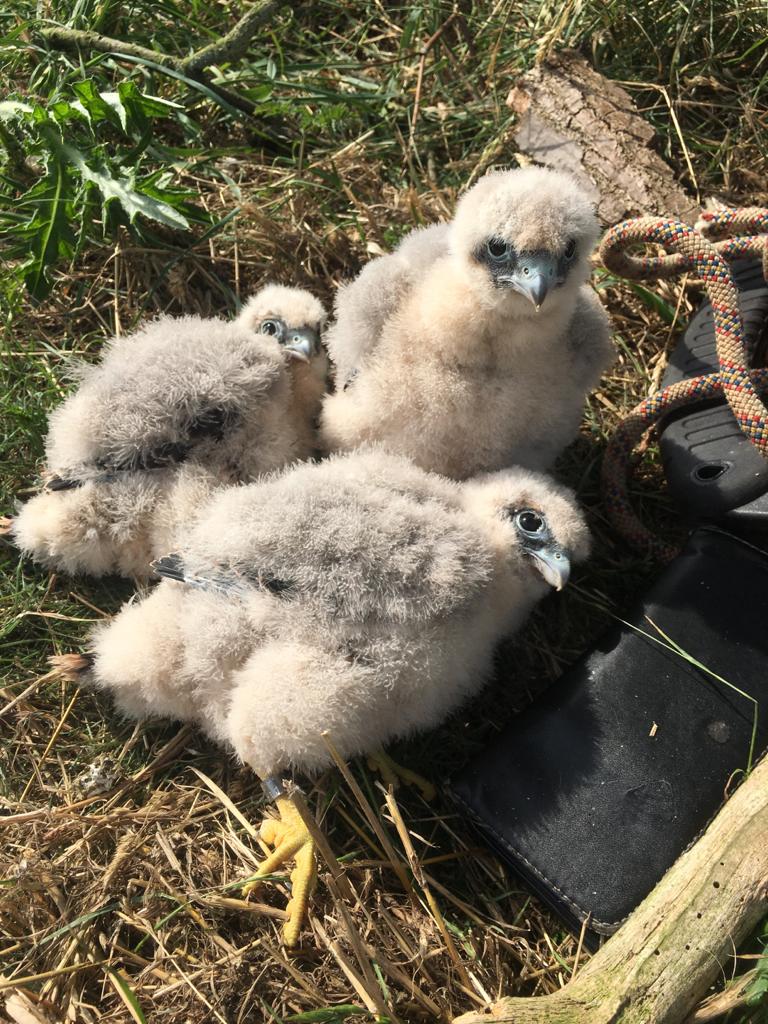
We would like to thank the finders for reporting these birds, more details of what to do if you find a ringed bird or a dead bird of prey can be found HERE
Could we remind you that dead birds of prey found in good condition can be sent to The Predatory Bird Monitoring Scheme for analysis, they will send you a postage paid package for shipping. **Please note** If you suspect that a bird has been killed illegally, contact the police by calling 101 and ask for the matter to be referred to a Wildlife Crime Officer.
The Predatory Bird Monitoring Scheme (PBMS) is a long-term, national monitoring scheme that quantifies the concentrations of contaminants in the livers and eggs of selected species of predatory and fish-eating birds in Britain.
They monitor the levels of contaminants to determine how and why they vary between species and regions, how they are changing over time, and the effects that they may have on individual birds and on their populations.
What do you when your concerns are being ignored by the Police?
As a result of the the previous blog about the poisoned Buzzard in the Longdendale Valley the raptor group and Mark Thomas the Head of RSPB Investigations went to see the Derbyshire Police and Crime Commissioner.
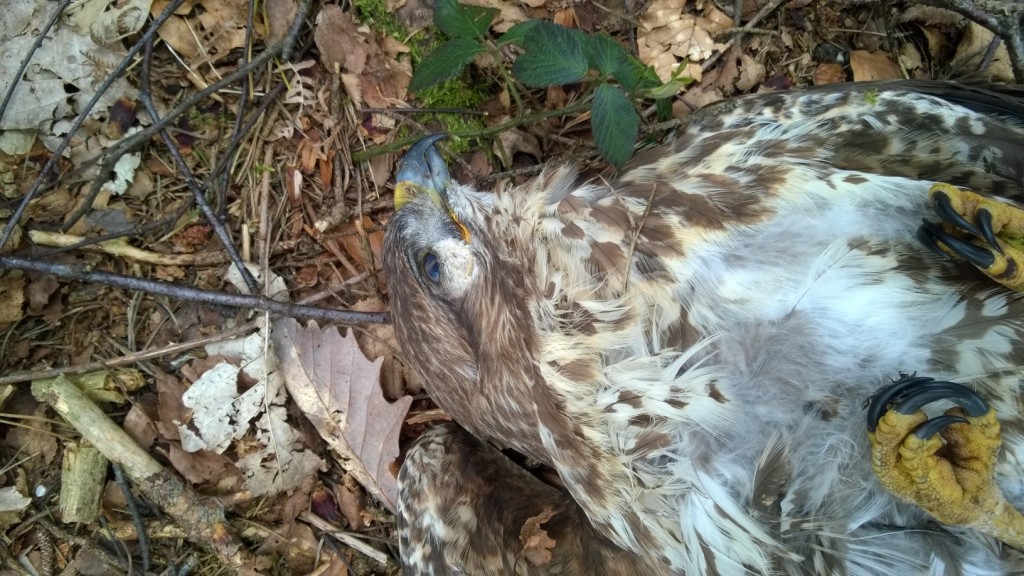
We were assured during the meeting that Derbyshire Police were keen to work with us on the issue of raptor persecution. We made it clear that we had some concerns regarding the way this case and the previous poisoning incident in this area had been handled, without any publicity from Derbyshire Police.
We shared this letter from Natural England’s Wildlife Incident Investigation Scheme with the Police and Crime Commissioner and explained that it is at odds with the message being sent out by the Rural Crime team.
However, tonight we saw the following post on the Derbyshire Rural Crime Team facebook https://www.facebook.com/ruralcrimeteam/photos/a.1924511090909080/3350766671616841/
We contacted the Rural Crime Team and asked them to discuss the post with us, they refused. We then contacted the DRCT coordinator and requested a correction or at very least the removal of the post on the Derbyshire Rural Crime Team Facebook page. It is clear that public displays like this are not conducive to working together and we agree, Derbyshire Police must concede that this situation could easily have been avoided by removal of the post (we would have preferred a correction) but both were refused.
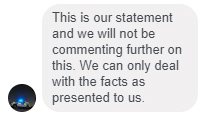
We have tonight sent this Open Letter to The Derbyshire Police and Crime Commissioner Hardyal Dhindsa, our comments are included in bold alongside the statements made in the post.
Dear Hardyal,
Thanks for taking the time to speak to Mark Thomas and myself last week.
I was somewhat surprised to see this tonight https://www.facebook.com/ruralcrimeteam/photos/a.1924511090909080/3350766671616841/
Unfortunately we feel it leaves me no choice but to respond publicly, this isn’t helping us moving forwards. It basically says we are lying about the findings from Natural England with regards to the poisoned Buzzard (the letter we shared with you at the meeting).
Below is the post from DRCT and our responses.
It has been brought to our attention that there have been social media posts relating to the suspicious death of a buzzard located in Derbyshire in April 2019 where poisonous substances were involved.
We can confirm that Derbyshire Constabulary has investigated this matter, which has unfortunately not resulted in any witnesses or suspects being identified. (It won’t Derbyshire Police haven’t made any appeal for information)
We understand that there have been concerns around the investigation and the potential risk to public health due to the alleged use of toxic chemicals. (Yes it was in a public place where people walk dogs with their families)
The Natural England, Wildlife Incident Investigation Scheme (WIIS) have carried out post mortem and toxicology tests, which concluded the bird died of poisoning. (and the remains of a poisoned bait)
There are too many unknown variables to conclusively say that the buzzard has been poisoned deliberately. All that can conclusively be said is that the buzzard has died as a result of ingesting poison. Its death has been recorded as suspicious. (There is plenty of evidence, as per the letter from NE that I shared with you)
The buzzard carcass and trace of poison – Natural England stated the Buzzard died as the result of the deliberate and illegal use of a high concentration of chloralose on a partridge bait were not found on land associated with gamebird management. (No but they were approximately 150 m from a Pheasant shoot and 1500 m from a Grouse moor)
Please let us reassure, that when Derbyshire Constabulary receive a report of any criminality it will be investigated robustly. Whether that report is made at the time of the offence or at a later date.
Can I also assure you that if any risk to public health arose, Derbyshire Constabulary would take the appropriate steps and work with partner agencies to mitigate any risk and protect the public (2 Poisonings in that area one involving at least 15 birds (2015) and now this poisoning both with Alpha chloralose and no information shared with the public about it).
Derbyshire Constabulary take all forms of criminality seriously, and wildlife crime is no exception.
To this end we have trained and dedicated a team of Police officers, in the Rural Crime Team to specifically deal with rural and wildlife crime.
If you have information of Raptor persecution in Derbyshire, please get in touch with the team DRCT@derbyshire.police.uk
The Peak District Bird of Prey Initiative
The internal affairs of the Peak District Bird of Prey Initiative are not something we would usually publicly comment on.
However, the annual report is being discussed once again and we are in a position where clear evidence of persecution is not being considered, and more worryingly untruths are being shared.
This should of course be an internal conversation; however, an email has been circulated by an individual representing a shooting organisation and copied into this email correspondence is at least one individual who is not directly involved in the Bird of Prey Initiative. This has caused us serious concerns. Some of the comments in that email are at best incorrect and some of the other comments (not the subject of this blog) could be considered slanderous to the identifiable individual. We believe this is a direct attempt to redirect the focus away from illegal raptor persecution.
It is the issue of the clear evidence of crime that is the subject of this blog.
On the 14th of April 2019, two members of the raptor group discovered a dead Buzzard in the Longdendale Valley near Tintwistle. They considered the death of the Buzzard to be suspicious due to finding a part-eaten gamebird and a dead wood mouse at the scene (mice are omnivores and will eat almost anything).

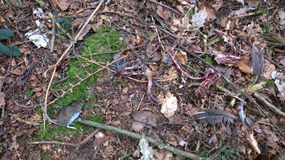
The finders called another member of the Raptor Group for advice and it was suggested that they should ring RSPB investigations. The RSPB attended quickly and sent the Buzzard, the mouse and the partridge remains to the Wildlife Incident Investigation Scheme (WIIS)* and informed Derbyshire Police.
Peak District Raptor Monitoring Group are not party to the police response to this incident, but it is noteworthy that this poisoned bird and the poisoned bait (for that is what the WIIS quarterly report states) don’t appear to have been the subject of a public appeal for information. There also doesn’t appear to have been any public warning that there has been a poisoning incident in an area where families and dog walkers are often seen.
This is not the first poisoning incident involving Alpha Chloralose in the valley in recent years.
WIIS publish a quarterly report of their findings and it is from this document that we can find a few more details:

It appears from the email circulated that the case was closed prior to the groups previous meeting, to quote the email:
“Regarding the Buzzard, this was discussed at the last meeting and after a conference call with the lead officer involved with the case he confirmed that the case was now closed and categorised as suspicious. The death could be equally be (sic) associated with a legitimate rodent control programme, and so it could be attributed to secondary poisoning definitely not “illegal persecution” which infers with to some kind of foul play that will yet again be laid at the door of gamekeepers. Without a PM on the mouse we will never know”.
Secondary poisoning occurs when an animal containing traces of poison is consumed by another.
This clearly is not a case of secondary poisoning, we have seen a document from WIIS that states “It appears that the abuse of chloralose, using a bird bait, has occurred at this location and at least one buzzard has been poisoned”.
Hopefully this clears up the incident which was misrepresented in the circulated email, and those that were copied into said email have the opportunity to learn the correct facts of the case before they repeat them too often. We believe that the other comments in the email are being looked into legally.
*The Wildlife Incident Investigation Scheme (WIIS) is a government agency who investigate the deaths of wildlife, pet animals and beneficial invertebrates in the UK if there is evidence to suggest that they may have been poisoned or put at risk by pesticides.
Hobby Recovery – EY03640

The Eurasian Hobby is a migratory species. Birds arrive in the UK from early April and head off on migration in September/October.
The entire British breeding population of Hobbies migrates south to spend the winter months in tropical Africa; the exact location is still a bit of a mystery, although two birds fitted with satellite tags in Germany spent the winter months on the southern edge of the Congo rainforest, in Angola, this might hint at the winter location of some British Hobbies too.
EY03640 was 1 of 3 chicks ringed from a nest in West Yorkshire on the 28th July 2018, the bird had completed one full migration when it was found injured with a shoulder fracture, near to Settiner See in the Ludwigslust-Parchim district, Germany and was released after care.

It is fairly safe to assume that this bird returned to Europe after overwintering in Southern Africa. Whilst we have no exact details of where this particular bird migrated to or the exact route or destination, we have attached a rough map showing that this bird had in all probability travelled almost 10,000 miles since leaving the nest approximately 340 days previously.

Recoveries – Merlin
We’ve not had any recoveries for a while but this week we have had three.
Two of these were Merlin ringed at a nest in the north of the Peak District National Park on the 18/6/2019, the nest fledged four young.
A male bird DD47979, unfortunately hit a window whilst chasing Starlings near Kidlington, Oxfordshire (the green line). Found 146 days after ringing and a distance of 192 km from the nest site.
His sibling a female bird EZ54326, was caught by a ringer at Holme Bird Observatory Norfolk and released after biometrics were recorded (the yellow line). Caught 132 days after ringing and a distance of 158 km from the nest site.
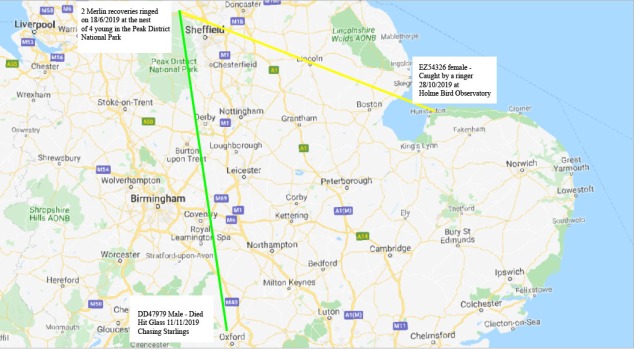
We would like to thank the finders for reporting these birds, more details of what to do if you find a ringed bird or a dead bird of prey can be found HERE
Could we remind you that dead birds of prey found in good condition can be sent to The Predatory Bird Monitoring Scheme for analysis, they will send you a postage paid package for shipping. **Please note** If you suspect that a bird has been killed illegally, contact the police by calling 101 and ask for the matter to be referred to a Wildlife Crime Officer.
The Predatory Bird Monitoring Scheme (PBMS) is a long-term, national monitoring scheme that quantifies the concentrations of contaminants in the livers and eggs of selected species of predatory and fish-eating birds in Britain.
They monitor the levels of contaminants to determine how and why they vary between species and regions, how they are changing over time, and the effects that they may have on individual birds and on their populations.
Peregrine rescue
Yesterday we received a call about a young Peregrine Falcon that had ended up on the ground and was being attacked by crows.
Luckily someone had spotted it and recognised the danger the bird was in. The juvenile Peregrine was put in a box in a quiet place whilst assistance was sort. Eventually they were put in touch with the raptor group and we collected the bird. It was kept overnight by a local falconer who checked the bird over and ensured it was feeding ok.
In the meantime one of the raptor group members spent a few hours in the area that the bird was found in and located where the birds had bred and confirmed that the parents were still around.
Having been given a clean bill of health the bird was returned to the roof of the building, with the permission of the owners and the help of their staff.
There was a second juvenile (probably female) on an adjacent building and the adults were very interested in what we were doing and no doubt soon heard the calling of this young bird.
We are hoping that we will be able to erect a nest platform for next year to save them nesting on a Jackdaw nest as they have done this year.
A big thank you to everyone involved, here’s hoping that this little male has better luck with his second chance.
Goshawk – Ladybower
On the 14th November 2018, we read a report from Derbyshire Constabulary Wildlife Crime Officer
We were quite hopeful for a full recovery for this bird, he was bright and alert and there were no signs of external trauma.
An x-ray showed a dense, circular object of approximately 2mm inside, as a result the bird was re-examined, with no evidence of a wound it was proposed that this was possibly a shotgun pellet ingested from a previously shot prey item (however this was not the case).
To aid the expected recovery, the Goshawk was put with an experienced bird of prey handler for rehabilitation and initially showed some progress. Unfortunately the bird died a few days later.
The dead bird was sent for a post-mortem and found to be in good condition with no signs of external injury.
When the abdomen was examined during the post-mortem the object was not found and a subsequent x-ray revealed it was still present in the Goshawk.
Dissection revealed a piece of lead shot in the left pectoralis muscle
Although the lead shot was unlikely to be the cause of the demise of this bird, it is yet another example of illegal bird of prey persecution. We cannot say for sure that this happened in the Peak District, but it is highly likely given the well documented history of persecution in this area.
Peak Malpractice 2006 – RSPB
Peak Malpractice update 2007 – RSPB
The Peak District Bird of Prey Initiative 2018 – Peak District National Park Authority, The National Trust, The Moorland Association, Natural England and both the local Raptor Groups (The RSPB left the Initiative in early 2018 due to a lack of progress and ongoing raptor persecution incidents).
Raptor Persecution in the Peak District National Park – Melling et al 2018, this document highlights the fortunes of breeding peregrine and goshawk in the Peak District National Park and the association of raptor persecution with driven grouse shooting.
Thanks are due to the person who reported the injured bird, the police officer(s) who responded and took the bird for treatment, the bird of prey handler for their efforts to rehabilitate the bird and of course the vet for all of their work undertaken to try to save and the bird and then investigate the cause of death.
Peregrine nest fails in suspicious circumstances
Raptor persecution in the Dark Peak area of the Peak District National Park is well documented, the links below give some background to historical and current persecution in the area and some background to this blog.
Peak Malpractice 2006 – RSPB, Peak Malpractice update 2007 – RSPB, The Peak District Bird of Prey Initiative 2018 – Peak District National Park Authority, National Trust, Moorland Association, Natural England and both the local Raptor Groups (The RSPB left the Initiative in early 2018 due to a lack of progress and ongoing raptor persecution incidents). Raptor Persecution in the Peak District National Park – Melling et al 2018, this document highlights the fortunes of breeding peregrine and goshawk in the Peak District National Park and the association of raptor persecution with driven grouse shooting.
The subject of this blog is a peregrine falcon breeding attempt in the Glossop area of the Peak District National Park.
The breeding attempt failed suddenly in circumstances that we consider suspicious.
On the 26th of March 2019, two raptor workers checking historic peregrine breeding sites witnessed a food pass between an adult male and female peregrine falcon close to a remote crag on a grouse moor.
The male was behaving territorially towards a kestrel which strayed too close to the potential nesting crag. We consider such behaviour in a suitable nesting area during the breeding season as indicative of a breeding attempt.
In case the pair had not yet commenced breeding we opted not to check the crag, instead observing from a suitable distance and planning a return visit in a week or two.
On the 8th of April 2019, we returned to the crag and were surprised to find that no birds were present in the area, on investigation of the crag we discovered 3 cold peregrine falcon eggs.
The question is what happened to this pair of peregrine falcons? Why were they no longer present? Peregrine falcons do not just give up on a breeding attempt after investing their energy in producing and laying eggs unless something has befallen one or both breeding birds. Another statistic in a long line of incidents that have befallen breeding birds of prey in the Dark Peak Area and another example of the reduced probability of peregrine falcon nesting successfully in the Dark Peak region.
This incident has been reported to Derbyshire Police and the RSPB and is now under investigation. Finding evidence or witnesses in cases such as these is uncommon so if you see or hear anything relating to such incidents, please contact Derbyshire Police on 101.

